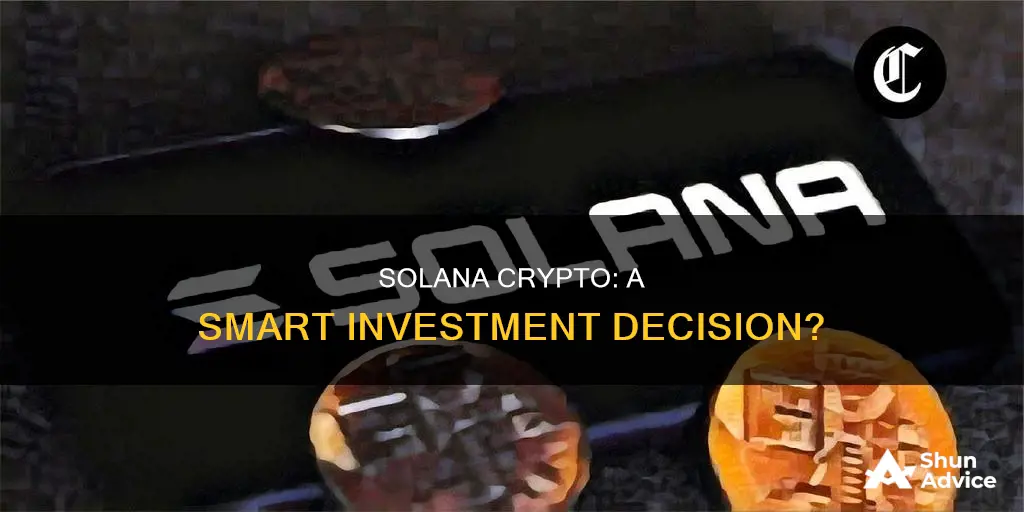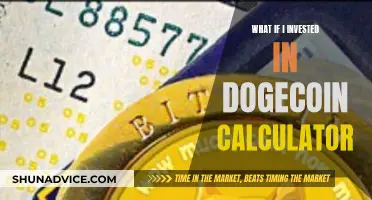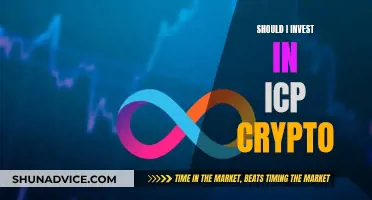
Solana (SOL) is a cryptocurrency that has gained traction and widespread popularity in the last few years. It has been touted as Ethereum's biggest rival due to its fast transaction speeds and low fees. Despite its popularity, Solana has faced several challenges, including network outages and instability. In this paragraph, we will explore the pros and cons of investing in Solana and whether it is a good investment option.
What You'll Learn

Solana's performance in 2021
Solana's unique selling point is its ability to process transactions quickly at a low cost. It can support 50,000 transactions per second, compared to Ethereum's 14, giving it a competitive edge in the market. This has attracted a lot of interest from both small-time and institutional traders, and its performance in 2021 solidified its position as a strong competitor to Ethereum.
However, it is important to note that Solana's network suffered repeated outages in 2021, which impaired its price and aspirations to become the "Visa of crypto". Despite these setbacks, Solana's performance in 2021 was overall positive, and it established itself as a leading blockchain platform.
Grin Coin: A Smart Investment Decision?
You may want to see also

Pros and cons of investing in Solana
Pros of Investing in Solana
Solana has been the best-performing crypto in 2021 and has continued to be a top performer in 2022 and 2023. It has risen through the ranks of altcoins to become the fourth or fifth-largest cryptocurrency in the world. Its growing community of investors is excited about how Solana's technology compares to market leaders like Bitcoin and Ethereum. Here are some pros of investing in Solana:
- Speed and fees: Solana's biggest selling point is its transaction speed. It can support tens of thousands of transactions per second compared to only about 13-15 transactions for Ethereum. This ease of verification also helps Solana have lower fees than Ethereum. Solana’s average fee is less than 1 cent per transaction.
- NFTs and smart contracts: Ethereum was the first cryptocurrency to introduce smart contracts, but the popularity of smart contracts and dApps has led to congestion on the Ethereum network. Solana is gaining market share in the high-growth non-fungible token world. NFT buyers on the Solana network enjoy faster transaction speeds and lower fees than those on the Ethereum network.
- Environmental impact: One of the biggest criticisms of Bitcoin and Ethereum is their negative environmental impact. Solana's PoS and PoH verification process is far less energy-intensive, potentially making the crypto a greener alternative.
Cons of Investing in Solana
Solana is a relative newcomer, and its extreme volatility suggests that it is still a high-risk, speculative investment. Here are some cons of investing in Solana:
- Fewer projects: Ethereum's first-mover advantage means that it has far more projects than Solana. Ethereum has thousands of dApps, while Solana has only 260-350 total dApps on its network.
- Inflation: Most digital currencies have a hard cap on the total number of coins that will ever exist. Solana, on the other hand, does not have a fixed number of coins. Its creators began increasing the yearly supply of SOL tokens by 8%, which means that the inflation rate will decrease by 15% until it reaches 1.5%.
- Unstable network: Solana's investor community is still in its early stages and has a shorter track record than Ethereum. In 2022, Solana suffered nine outages in a two-month period, seven of which were major. In February 2023, the Solana network was down for nearly 20 straight hours. In February 2024, it was down for five hours.
- Not decentralized enough: The ETH network has over 200,000 validators, but the Solana network only has 1,000 validators. The more validators a network has, the more secure it is.
- Testing phases: Solana has big plans for the future, but many of those plans are still in beta testing.
Solana Crypto: Is It Worth Investing?
You may want to see also

Solana's price history
Solana Price History
Solana (SOL) is a cryptocurrency that has been described as Ethereum's biggest rival. It was founded in 2017 by Anatoly Yakovenko, a former Qualcomm employee, and his colleague Greg Fitzgerald.
In January 2023, SOL prices recovered to some extent, rallying to $17.36 on 9 January, before falling back down to around $16.10 on 12 January. It broke past $20 for the first time since November on 14 January, and market conditions saw it stay above that level, peaking at $26.93 on 20 February 2023.
In March 2023, the collapse of Silvergate Bank shook the crypto market, and SOL dropped to a low of $16.12 on 10 March. It recovered to $23.83 on 20 March, but by 6 April 2023, it was trading at around $20.70. On 11 April, SOL shot up by over 10% over the course of the day, opening at $20.88 and closing at $23.02, before continuing to grow to peak at $25.46 on 14 April.
As of 17 April 2023, SOL was trading at around $24.85. There were a little over 392.3 million SOL in circulation, with a total supply of about 539 million. This gave the coin a market cap of about $9.7 billion, making it the 10th-largest crypto by that metric.
In 2024, SOL continued its upward trajectory. On 17 August 2024, it was trading at $142.7328, and on 24 September 2024, it was valued at $143.29.
Strategizing Bitcoin Investment: A Long-Term Guide
You may want to see also

Predictions for the future of Solana
Solana is a cryptocurrency that has gained traction and widespread popularity in the last few years. Its rise has attracted the attention of many investors, and it is currently ranked No. 5 in the entire crypto ecosystem.
- Solana's price is expected to continue its upward trajectory in the short term. According to a Solana price forecast, its value will increase by 0.98% and reach $144.69 by September 25, 2024. The average trading price is expected to be around $173.44 in 2024.
- In the long term, Solana is predicted to perform well. By 2025, the maximum expected SOL price may be around $208.67, with an average trading price of $274.65. By 2026, the average expected trading cost is predicted to be $306.61, and by 2027, the average trading cost is expected to be around $458.62.
- Solana has the potential to become a leading platform for NFT activities due to its high throughput and low transaction costs. This could further boost its market attractiveness and contribute to its growth.
- The anticipated approval of a Solana ETF and successful airdrops have been cited as factors that could enhance its market attractiveness.
- The future outlook for Solana is promising, but there are also potential hurdles. One of the main challenges is the trade-off between scalability and decentralization. Solana has sacrificed some decentralization to achieve higher scalability, which could be tested against the evolving demands of the blockchain market.
- Long-term forecasts predict that SOL will peak at $1,672 by 2030.
In conclusion, the future of Solana looks bright, with potential for significant growth and innovation. However, it is important to remember that the cryptocurrency market is highly volatile and unpredictable, and there are challenges that Solana needs to navigate.
Dogecoin App: Invest Wisely with These Tips
You may want to see also

How Solana compares to other cryptocurrencies
Solana (SOL) is a cryptocurrency that was designed to work similarly to Ethereum and improve upon it. It is often referred to as an "Ethereum killer". Like Ethereum, the SOL token can be purchased on most major exchanges. However, SOL offers much faster transaction speeds and lower fees. While Ethereum can currently process 14 transactions per second, Solana can support 50,000. This gives Solana a competitive edge over Ethereum in terms of transaction speeds and costs.
Solana is also similar to Ethereum in that it uses a proof-of-stake consensus mechanism. However, Solana combines this with a proof-of-history consensus mechanism, which timestamps each block in a way that maintains the system's security. This combination of mechanisms allows Solana to achieve consensus more quickly, while reducing the workload and maintaining the blockchain's decentralised nature.
In addition to Ethereum, Solana is also compared to other cryptocurrencies such as Bitcoin and Litecoin, which use a proof-of-work algorithm to define the blocks in their chains. The proof-of-work system is slow and resource-heavy, leading to high energy consumption. In contrast, Solana's proof-of-history mechanism allows for faster, more secure computations, and reduced environmental and monetary costs.
Solana has also been compared to Cardano (ADA) in terms of transaction speeds and costs. Solana offers faster transaction speeds than Cardano at a fraction of the cost.
Overall, Solana stands out from other cryptocurrencies with its fast transaction speeds, low fees, and innovative use of a proof-of-history consensus mechanism.
BTS Coin: A Smart Investment Move?
You may want to see also
Frequently asked questions
Solana has been the best-performing crypto in 2021 and has continued to grow since then. It has fast transactions and low fees, and it is gaining market share with Solanart, an NFT marketplace. Solana also has the third-largest futures market.
Solana is not decentralized enough, with only 1,000 validators compared to Ethereum's 200,000. It also has fewer projects than Ethereum and no fixed supply of coins. The Solana blockchain has also been prone to network outages.
As of 22 September 2024, the live price of Solana crypto is $147.28. Solana Price Prediction estimates that the price could reach a high of $350 by the end of 2024 and $1,672 by the end of 2030.







